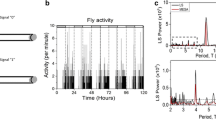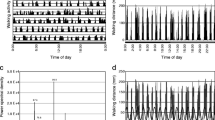Abstract
Adults of Drosophila melanogasterhad their locomotor activity monitored under conditions of cycling light and dark (12 h each per cycle). The elementary behavior of wild-type flies under these “LD” conditions fluctuated between levels of high and levels of low activity. Two high-activity peaks occurred within a given cycle: one at about dawn; the other, at around dusk. Such accentuated activity levels gradually subsided to troughs in the middle of the day and of the night, after which the flies anticipated the next environmental transition by gradually becoming more active. Descriptions of these activity profiles were augmented by newly developed formal analyses of the “diel rhythm” phases (based in part on digital filterings of the raw behavioral data). The applications of these analyses led to objective, automated determination of when in the morning and the evening the flies' activity peaks occur. This normal diel behavior was compared to the locomotor activity and phase determinations for a series of rhythm variants. Most of these involved mutations at the period (per)locus and germ-line transformants bearing normal or altered forms of DNA cloned from this “clock gene.” Such genetic variants have been shown previously to exhibit, in constant darkness, strain-specific circadian periods ranging from about 19 to about 29 h. We now show that the phases of the evening peaks of activity under LD conditions were correspondingly earlier than normal for the short-period mutants and later than normal for those with long circadian cycle durations. The morning peaks, however, moved (in comparison to the normal phase position) minimally under the influence of a given pervariant.
Similar content being viewed by others
References
Aschoff, J. (1981). Freerunning and entrained circadian rhythms. In Aschoff, J. (ed.),Handbook of Behavioral Neurobiology, Vol. 4:Biological Rhythms, Plenum Press, New York, pp. 81–93.
Aschoff, J., and Pohl, H. (1978). Phase relations between a circadian rhythm and its Zeitgeber within the range of entrainment.Naturwissenchaften 65: 80–84.
Baylies, M. K., Bargiello, T. A., Jackson, F. R., and Young, M. W. (1987). Changes in abundance and structure of theper gene product can alter periodicity of theDrosophila clock.Nature 326: 390–392.
Citri, Y., Colot, H. V., Jacquier, A. C., Yu, Q., Hall, J. C., Baltimore, D., and Rosbash, M. (1987). A family of unusually spliced and biologically active transcripts encoded by aDrosophila clock gene.Nature 326: 42–47.
Dowse, H. B., and Ringo, J. M. (1989). The search for hidden periodicities in biological time series revisited.J. Theoret. Biol. 139: 487–515.
Dowse, H. B., and Ringo, J. M. (1992). Is the circadian clock a “metaoscillator”? Evidence from studies of ultradian rhythms inDrosophila. In Young, M. W. (ed.),Molecular Genetics of Biological Rhythms, Marcel Dekker, New York (in press).
Dushay, M. S., Rosbash, M., and Hall, J. C. (1989). Thedisconnected visual system mutations inDrosophila melanogaster drastically disrupt circadian rhythms.J. Biol. Rhythms 4: 1–27.
Dushay, M. S., Konopka, R. J., Orr, D., Greenacre, M. L., Kyriacou, C. P., Rosbash, M. and Hall, J. C. (1990). Phenotypic and genetic analysis ofClock, a new circadian rhythm mutant inDrosophila melanogaster.Genetics 125: 557–578.
Engelmann, W., and Mack, J. (1978). Different oscillators control the circadian rhythm of eclosion and activity inDrosophila.J. Comp. Physiol. 127: 229–237.
Hall, J. C. (1990). Genetics of circadian rhythms.Annu. Rev. Genet. 24: 659–697.
Hall, J. C., and Kyriacou, C. P. (1990). Genetics of biological rhythms inDrosophila.Adv. Insect Physiol. 22: 221–298.
Hall, J. C., and Rosbash, M. (1987). Genes and biological rhythms.Trends Genet. 3: 185–191.
Hamblen, M., Zehring, W. A., Kyriacou, C. P., Reddy, P., Yu, Q., Wheeler, D. A., Zwiebel, L. J., Konopka, R. J., Rosbash, M., and Hall, J. C. (1986). Germ-line transformation involving DNA from theperiod locus inDrosophila melanogaster: Overlapping genomic fragments that restore circadian and ultradian rhythmicity to per0 and per− mutants.J. Neurogenet. 3: 249–291.
Hamblen-Coyle, M., Konopka, R. J., Zwiebel, L. J., Colot, H. V., Dowse, H. B., Rosbash, M., and Hall, J. C. (1989). A new mutation at theperiod locus with some novel effects on circadian rhythms.J. Neurogenet. 5: 229–256.
Hardin, P. E., Hall, J. C., and Rosbash, M. (1990). Feedback of theDrosophila period gene product on circadian cycling of its messenger RNA.Nature 343: 536–540.
Helfrich, C., and Engelmann, W. (1987). Evidences for circadian rhythmicity in the per0 mutant ofDrosophila melanogaster.Z. Naturforsch. 42C: 1335–1338.
Illnerová, H., and Vanecek, J. (1982). Two-oscillator structure of the pacemaker controlling the circadian rhythm of N-acetyltransferase in the rat pineal gland.J. Comp. Physiol. 145: 539–548.
Jackson, F. R. (1983). The isolation of biological rhythm mutations on the autosomes ofDrosophila melanogaster.J. Neurogenet. 1: 3–15.
Jackson, F. R. (1992). Circadian rhythm mutants ofDrosophila. In Young, M. W. (ed.),Molecular Genetics of Biological Rhythms, Marcel Dekker, New York (in press).
Konopka, R. J. (1979). Genetic dissection of theDrosophila circadian system.Fed. Proc. 38: 2602–2605.
Konopka, R. J. (1986). Neurogeneticsof Drosophila circadian rhythms. In Huettel, M. D. (ed.),Evolutionary Genetics of Insect Behavior, Plenum Press, New York, pp. 215–221.
Konopka, R. J., and Benzer, S. (1971). Clock mutants ofDrosophila melanogaster.Proc. Natl. Acad. Sci. USA 68: 2112–2116.
Konopka, R. J., and Orr, D. (1980). Effects of clock mutations on the subjective day—Implications for a membrane model of theDrosophila circadian clock. In Siddiqi, O., Babu, P., Hall, L. M., and Hall, J. C. (eds.),Genetics and Neurobiology of Drosophila, Plenum Press, New York, pp. 409–416.
Konopka, R. J., Pittendrigh, C., and Orr, D. (1989). Reciprocal behavior associated with altered homoeostasis and photosensitivity ofDrosophila clock mutants.J. Neurogenet. 6: 1–10.
Konopka, R. J., Smith, R. F., and Orr, D. (1991). Characterization ofAndante, a newDrosophila clock mutant, and its interaction with other clock mutants.J. Neurogenet. 7: 103–114.
Liu, X., Yu, Q., Huang, J., Zwiebel, L. J., Hall, J. C., and Rosbash, M. (1991). The strength and periodicity of D. melanogaster circadian rhythms are differentially affected by alterations inperiod gene expression.Neuron 6: 753–766.
Newby, L. M., White, L., DiBartolomeis, S. M., Walker, B. J., Dowse, H. B., Ringo, J. M., Khuda, N., and Jackson, F. R. (1991). Mutational effects of the Drosophilaminiature-dusky (m-dy) locus: Effects on cell size and circadian rhythms.Genetics 128: 571–582.
Orr, D. P.-Y. (1982).Behavioral Neurogenetic Studies of a Circadian Clock in Drosophila melanogaster, Ph. D. thesis, California Institute of Technology, Pasadena.
Pak (1991). Molecular genetic studies of photoreceptor function usingDrosophila mutants.Prog. Clin. Biol. Res. 362: 1–32.
Petersen, G., Hall, J. C., and Rosbash, M. (1988). Theperiod gene ofDrosophila carries speciesspecific behavioral instructions.EMBO J. 7: 3939–3947.
Pittendrigh, C. S. (1981). Circadian organization and the photoperiodic phenomena. In Follett, B. K. (ed.),Biological Clocks and Reproductive Cycles, John Wright, Bristol, UK, pp. 1–35.
Pittendrigh, C. S., and Daan, S. (1976). A functional analysis of circadian pacemakers in nocturnal rodents. V. Pacemaker structure: A clock for all seasons.J. Comp. Physiol. 106: 333–355.
Pittendrigh, C. S., and Minis, D. H. (1964). The entrainment of circadian oscillations by light and their role as photoperiodic clocks.Am. Nat. 98: 261–294.
Ralph, M. R., and Menaker, M. (1988). A mutation of the circadian system in golden hamsters.Science 241: 1225–1227.
Rosbash, M., and Hall, J. C. (1989). The molecular biology of circadian rhythms.Neuron 3: 387–398.
Rutila, J. E., Edery, I., Hall, J. C., and Rosbash, M. (1992). The generation and analysis of short-period behavioral rhythm mutants inD. melanogaster suggests potential mechanisms ofperiod gene function.J. Neurogenet. 8: 101–113.
Saunders, D. S. (1982).Insect Clocks, 2nd ed., Pergamon Press, Oxford, UK.
Smith, R. F., and Konopka, R. J. (1981). Circadian clock phenotypes of chromosome aberrations with a breakpoint at theper locus.Mol. Gen. Genet. 183: 243–251.
Smith, R. F., and Konopka, R. J. (1982). Effects of dosage alterations at theper locus on the period of the circadian clock ofDrosophila.Mol. Gen. Genet. 185: 30–36.
Sokolove, P. G., and Bushnell, W. N. (1978). The chi square periodogram: Its utility for analysis of circadian rhythms.J. Theoret. Biol. 72: 131–160.
Sulzman, F. M. (1982). Microcomputer monitoring of circadian rhythms.Comput. Biol. Med. 12: 253–261.
Vafopoulou, X., and Steel, C. G. H. (1991). Circadian regulation of synthesis of ecdysteroids by prothoracic glands of the insectRhodnius prolixus: Evidence of a dual oscillator system.Gen. Comp. Endocrinol 83: 27–34.
Vosshall, L. B., and Young, M. W. (1992). Circadian behavior defects of eye, optic lobe, and brain mutants ofDrosophila melanogaster. In Young, M. W. (ed.),Molecular Genetics of Biological Rhythms, Marcel Dekker, New York.
Winfree, A. T. (1987).The Timing of Biological Clocks, Scientific American Library, New York.
Winfree, A. T., and Gordon, H. (1977). The photosensitivity of a mutant circadian clock.J. Comp. Physiol. 122: 87–109.
Young, M. W., Bargiello, T. A., Baylies, M. L., Saez, L., and Spray, D. C. (1989). Molecular biology of theDrosophila clock. In Jacklet, J. W. (ed.),Neuronal and Cellular Oscillators, Marcel Dekker, New York, pp. 529–542.
Yu, Q., Colot, H. V., Kyriacou, C. P., Hall, J. C., and Rosbash, M. (1987a). Behaviour modification byin vitro mutagenesis of a variable region within theperiod gene ofDrosophila.Nature 326: 765–769.
Yu, Q., Jacquier, A. C., Citri, Y., Hamblen, M., Hall, J. C., and Rosbash, M. (1987b). Molecular mapping of point mutations in theperiod gene that stop or speed up biological clocks inDrosophila melanogaster.Proc. Natl. Acad. Sci. USA 84: 784–788.
Zehring, W. A., Wheeler, D. A., Reddy, P., Konopka, R. J., Kyriacou, C. P., Rosbash, M., and Hall, J. C. (1984). P-element transformation withperiod locus DNA restores rhythmicity to mutant, arrhythmic Drosophila melanogaster.Cell 39: 369–376.
Zerr, D. M., Hall, J. C., Rosbash, M., and Siwicki, K. K. (1990). Circadian fluctuations ofperiod protein immunoreactivity in the CNS and the visual system ofDrosophila.J. Neurosci. 10: 2749–2762.
Author information
Authors and Affiliations
Rights and permissions
About this article
Cite this article
Hamblen-Coyle, M.J., Wheeler, D.A., Rutila, J.E. et al. Behavior of period-altered circadian rhythm mutants ofDrosophila in light: Dark cycles (Diptera: Drosophilidae). J Insect Behav 5, 417–446 (1992). https://doi.org/10.1007/BF01058189
Accepted:
Issue Date:
DOI: https://doi.org/10.1007/BF01058189




